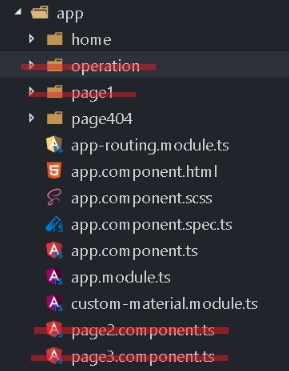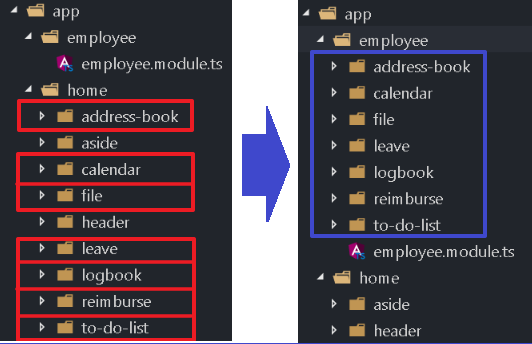模組化 在 Angular 模組 我們練習先建立一個模組(NgModule),然後在上面建立元件(Component),今天我們試著反過來將既有的元件包覆到一個模組內。
重整 先將用不到的元件及模組刪除:Pagex Component、Optx Component、OperationModule,直接刪除檔案,再將把註冊相關元件的模組(src\app\app.module.ts、src\app\app-routing.module.ts)程式碼給移除。
app.module.ts 1 2 3 4 5 6 7 8 9 10 11 12 13 14 15 16 17 18 19 20 21 22 23 24 25 26 27 import { BrowserAnimationsModule } from '@angular/platform-browser/animations' ;import { BrowserModule } from '@angular/platform-browser' ;import { NgModule } from '@angular/core' ;import { AppRoutingModule } from './app-routing.module' ;import { AppComponent } from './app.component' ;import { Page404Component } from './page404/page404.component' ;import { CustomMaterialModule } from './custom-material.module' ;import { HomeModule } from './home/home.module' ;@NgModule ({ declarations : [ AppComponent, Page404Component ], imports : [ BrowserModule, AppRoutingModule, BrowserAnimationsModule, CustomMaterialModule, HomeModule ], providers : [], bootstrap : [AppComponent] }) export class AppModule
app-routing.module.ts 1 2 3 4 5 6 7 8 9 10 11 12 13 14 15 import { NgModule } from '@angular/core' ;import { Routes, RouterModule } from '@angular/router' ;import { Page404Component } from './page404/page404.component' ;const routes: Routes = [ { path : '' , redirectTo : 'home' , pathMatch : 'full' }, { path : '404' , component : Page404Component } ]; @NgModule ({ imports : [RouterModule.forRoot(routes)], exports : [RouterModule] }) export class AppRoutingModule
因為 src\app\app.component.html 只有一行語法,所以直接將它併入 src\app\app.component.ts,相關的樣板檔(app.component.scss)以及測試檔(app.component.spec.ts)可以先移除,後續有需要時再加回來。
app.component.ts 1 2 3 4 5 6 7 8 import { Component } from '@angular/core' ;@Component ({ selector : 'app-root' , template : `<router-outlet></router-outlet>` }) export class AppComponent
整個專案應該會變乾淨很多。
建立模組 開始將在 Angular 子路由 所建立的功能元件都合併到一個模組內。ng g m employee 建立一個 EmployeeModule 模組。src\app\employee 下面,在可以透過 VS Code 的檔案總管用滑鼠直接拖拉,並將相關元件註冊到 src\app\employee\employee.module.ts。
employee.module.ts 1 2 3 4 5 6 7 8 9 10 11 12 13 14 15 16 17 18 19 20 21 22 23 24 25 26 import { NgModule } from '@angular/core' ;import { CommonModule } from '@angular/common' ;import { CalendarComponent } from './calendar/calendar.component' ;import { AddressBookComponent } from './address-book/address-book.component' ;import { LogbookComponent } from './logbook/logbook.component' ;import { ToDoListComponent } from './to-do-list/to-do-list.component' ;import { FileComponent } from './file/file.component' ;import { LeaveComponent } from './leave/leave.component' ;import { ReimburseComponent } from './reimburse/reimburse.component' ;@NgModule ({ imports : [ CommonModule ], declarations : [ CalendarComponent, AddressBookComponent, LogbookComponent, ToDoListComponent, FileComponent, LeaveComponent, ReimburseComponent ] }) export class EmployeeModule
再將相關元件從 src\app\home\home.module.ts 中移除參考,並將 EmployeeModule 註冊進來。
home.module.ts 1 2 3 4 5 6 7 8 9 10 11 12 13 14 15 16 17 18 19 20 21 22 23 24 25 import { NgModule } from '@angular/core' ;import { CommonModule } from '@angular/common' ;import { HomeRoutingModule } from './home-routing.module' ;import { HomeComponent } from './home.component' ;import { HeaderComponent } from './header/header.component' ;import { AsideComponent } from './aside/aside.component' ;import { CustomMaterialModule } from '../custom-material.module' ;import { EmployeeModule } from '../employee/employee.module' ;@NgModule ({ imports : [ CommonModule, HomeRoutingModule, CustomMaterialModule, EmployeeModule ], declarations : [ HomeComponent, HeaderComponent, AsideComponent ] }) export class HomeModule
最後的問題大概就是 HomeRoutingModule (src\app\home\home-routing.module.ts) 的路由規則要如何處理?
home-routing.module.ts 1 2 3 4 5 6 7 8 9 10 11 12 13 14 15 16 17 18 19 20 21 22 23 24 25 26 27 28 29 30 31 32 import { NgModule } from '@angular/core' ;import { Routes, RouterModule } from '@angular/router' ;import { HomeComponent } from './home.component' ;import { CalendarComponent } from './calendar/calendar.component' ;import { AddressBookComponent } from './address-book/address-book.component' ;import { FileComponent } from './file/file.component' ;import { LeaveComponent } from './leave/leave.component' ;import { LogbookComponent } from './logbook/logbook.component' ;import { ReimburseComponent } from './reimburse/reimburse.component' ;import { ToDoListComponent } from './to-do-list/to-do-list.component' ;const routes: Routes = [ { path : 'home' , component : HomeComponent, children : [ { path : '' , redirectTo : 'to-do-list' , pathMatch : 'full' }, { path : 'address-book' , component : AddressBookComponent }, { path : 'calendar' , component : CalendarComponent }, { path : 'file' , component : FileComponent }, { path : 'leave' , component : LeaveComponent }, { path : 'logbook' , component : LogbookComponent }, { path : 'reimburse' , component : ReimburseComponent }, { path : 'to-do-list' , component : ToDoListComponent } ] } ]; @NgModule ({ imports : [RouterModule.forChild(routes)], exports : [RouterModule] }) export class HomeRoutingModule
比較好的做法應該是將路由規則 path:'home' 下 children 屬性內的路由規則都移到 src\app\employee\ 資料夾內,維護上會比較方便。src\app\employee\employee.routing.ts),在將路由規則搬移至此,最後再將路由規則 export 出來。
employee.routing.ts 1 2 3 4 5 6 7 8 9 10 11 12 13 14 15 16 17 18 19 20 21 22 import { Routes } from '@angular/router' ;import { AddressBookComponent } from './address-book/address-book.component' ;import { CalendarComponent } from './calendar/calendar.component' ;import { FileComponent } from './file/file.component' ;import { LeaveComponent } from './leave/leave.component' ;import { LogbookComponent } from './logbook/logbook.component' ;import { ReimburseComponent } from './reimburse/reimburse.component' ;import { ToDoListComponent } from './to-do-list/to-do-list.component' ;const routes: Routes = [ { path : '' , redirectTo : 'to-do-list' , pathMatch : 'full' }, { path : 'address-book' , component : AddressBookComponent }, { path : 'calendar' , component : CalendarComponent }, { path : 'file' , component : FileComponent }, { path : 'leave' , component : LeaveComponent }, { path : 'logbook' , component : LogbookComponent }, { path : 'reimburse' , component : ReimburseComponent }, { path : 'to-do-list' , component : ToDoListComponent } ]; export const employeeRouter = routes;
接下來將 employeeRouter 變數指派回 src\app\home\home-routing.module.ts 的 children 屬性。
home-routing.module.ts 1 2 3 4 5 6 7 8 9 10 11 12 13 14 15 16 17 import { NgModule } from '@angular/core' ;import { Routes, RouterModule } from '@angular/router' ;import { HomeComponent } from './home.component' ;import { employeeRouter } from '../employee/employee.routing' ;const routes: Routes = [ { path : 'home' , component : HomeComponent, children : employeeRouter } ]; @NgModule ({ imports : [RouterModule.forChild(routes)], exports : [RouterModule] }) export class HomeRoutingModule
觀看執行結果其實感覺不出差異,但是對於系統維護上來說會更加便利。
[**first-app_2017-09-04.zip**](/uploads/first-app_2017-09-04.zip)





